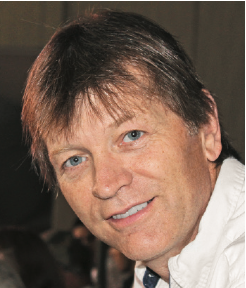Developing a Fast Purification Method for a Natural Product with a Preparative LC Column Packed with Superficially Porous Particles
A fast and simple purification method for withaferin A (WFA) in ashwagandha extract was successfully developed using a preparative column packed with superficially porous particles (SPPs). The SPP column provided better resolution and a 45% decrease in run time over a traditional preparative column packed with totally porous particles. The performance benefits of SPP preparative columns, especially at high flow rates, align well with the needs of pharmaceutical discovery laboratories and other high-throughput environments.
Superficially porous particle (SPP) chromatography columns are a popular choice for analytical method development. Columns packed with SPPs have higher efficiency and lower back pressure than their totally porous particle (TPP) counterparts (1). Figure 1 compares the two particle types (1). A SPP consists of a solid silica core surrounded by a porous silica outer layer. The solid core prevents the analyte from traveling too far into the particle, shortening its diffusion path and resulting in a narrower chromatographic peak.
FIGURE 1: Analyte diffusion path for a totally porous particle (TPP) versus a superficially porous particle (SPP).
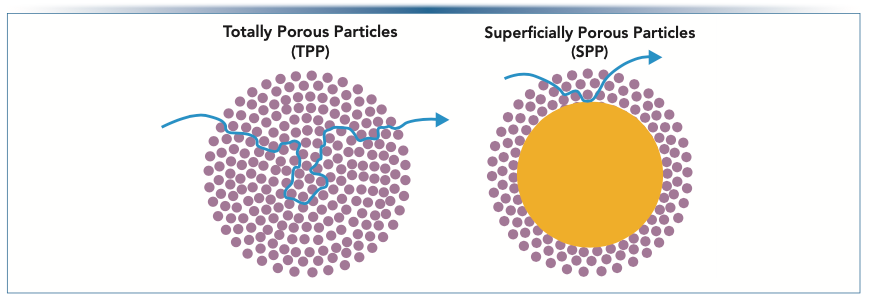
Using a van Deemter curve provides a simple way to compare the efficiency of SPP and TPP columns, where an isocratic separation of a void volume marker and analyte mixture is run across a wide range of flow rates. The efficiency, or plate number (N), of the analyte is calculated using equation 1, where tr is the analyte retention time and w1/2 is the peak width at half height.

From N, the plate height (H) can be calculated using equation 2, where L is the length of the column.

H is plotted against linear velocity (u), which is calculated from the retention time of the void volume marker (t0) using equation 3.

The van Deemter curve for a 4 μm SPP column and a 5 μm TPP column of the same column dimension are shown in Figure 2.
FIGURE 2: van Deemter plots of 4 μm SPP and 5 μm TPP columns.

Keeping in mind that H is inversely proportional to N, the curve with smaller H values has better performance. Looking at the curves, it is obvious that the 4 μm column performs better than its 5 μm counterpart. The linear velocity at the minimum of each curve (uopt) corresponds to the flow rate at which the column will have the highest efficiency. The SPP column had a uopt is 150% faster than the TPP column, which means that the SPP column can provide a better separation in less time than the TPP column.
Next, the data can be integrated in the van Deemter equation to calculate the A, B, and C terms (equation 4).

These constants represent the main contributions to band broadening. The impacts of the A term (eddy diffusion) and the B term (longitudinal diffusion) are significant at low linear velocities (<0.5 mm/s) and are discussed in the literature (2). At normal or above normal chromatographic linear velocities (>1.5 mm/s), the C term (resistance to mass transfer) is the main contributor to band broadening. For a TPP column, the long diffusion path of an analyte within the particle causes band broadening. The resistance to mass transfer only gets worse as the velocity increases. In contrast, the porous layer in an SPP column is much shorter. As a result, H is considerably lower for the SPP column, and the slope of the van Deemter curve at high flow rates (>3 mm/s) is shallower than it is for the TPP column. A lower H value allows the user to run SPP columns at higher flow rates without experiencing a significant decrease in performance.
Pharmaceutical discovery laboratories and other high-throughput environments regularly utilize preparative chromatography to purify large batches of samples. They require small amounts (10–100 mg) of high purity fractions for downstream workup and characterization. Given the fast-paced nature of these environments, minimal time can be spent on method development. Therefore, these customers could benefit from SPP columns that provide high resolution and throughput.
SPP columns have not been widely adopted in preparative LC for several reasons. Most analytical instrumentation has been designed to minimize system volume and exceed pressures of 400 bar, whereas most preparative instrumentation has large system volume to prevent pump overpressure. Using smaller-sized SPPs in a preparative column could cause excessive pressure, and a large system volume could negate the chromatographic benefits.
These concerns can be mitigated by using preparative columns packed with 4 μm SPPs. This particle size is large enough to operate well within the pressure range of traditional preparative instruments without significant band broadening while still performing better than traditional TPP preparative columns, especially at higher flow rates.
The purification of bioactive components in natural products represents a similar challenge to that of drug candidates in crude mixtures—both have complicated matrices. Withania somnifera (L.) Dunal, well known as ashwagandha, is a plant that contains many withanolides, which are natural steroids. Withaferin A (WFA) is the most bioactive withanolide in ashwagandha. This study focuses on the efficacy of a generic purification method for WFA on both a 4 μm SPP and traditional 5 μm TPP column at standard and elevated flow rates.
Experimental
Instrumentation
All work was performed on an Agilent 1290 Infinity II autoscale preparative liquid chromatography (LC) system.
Columns and Supplies
Purification methods were developed on two columns. The SPP column was an Agilent InfinityLab Poroshell 120 SB-C18, 21.2 × 150 mm, 4 μm preparative LC column, acquired from Agilent Technologies. The TPP column was a traditional C18, 19 × 150 mm, 5 μm preparative LC column acquired from Neta Scientific. The ashwagandha extract in 2:1 ethanol:water (100 mg/mL) was purchased from Banyan Botanicals. The WFA standard was purchased from Sigma Aldrich. LC grade solvents were acquired from Burdick and Jackson. The extract was filtered using Agilent Captiva premium syringe filter (0.2 μm).
Gradient Separation at Optimal Flow Rate
The optimal flow rate for each column was determined by its respective van Deemter curve (not shown). A previously published analytical method was used to select the mobile phase (3). A generic gradient was run on both columns, adjusting the gradient time to keep the number of column volumes in the gradient consistent. A summary of run conditions is shown in Table I.
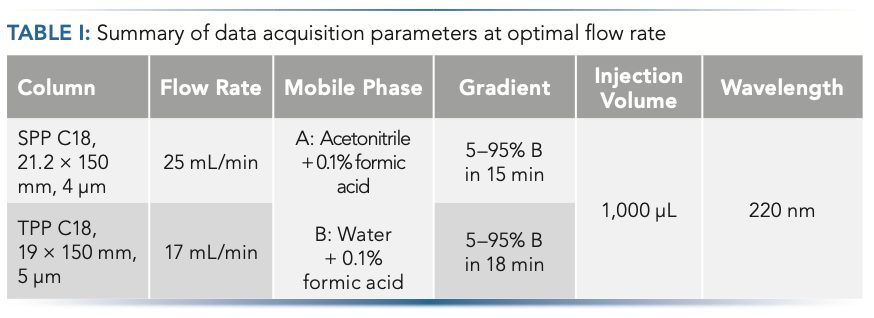
Gradient Separation at Elevated Flow Rate
Each column was run at 50% above its optimal flow rate. The gradient time was adjusted to keep the number of column volumes in the gradient consistent. A summary of the run conditions is shown in Table II.

Results and Discussion
Figure 3 shows a comparison of both columns run at their respective optimal flows. The total mass on each column was 100 mg. The WFA peak eluted at 8.59 min on the SPP column and at 9.66 min on the TPP column. Both columns provided separation between the WFA peak and the adjacent impurities. The impurities had baseline separation with WFA on the SPP column. However, on the TPP column, one of the impurities appeared as a shoulder of the WFA peak.
FIGURE 3: Withaferin A (WFA) separation on preparative LC columns. Gradient time: (a) SPP column—15 min and (b) TPP column—18 min. Inset subfigures show impurities peaks.
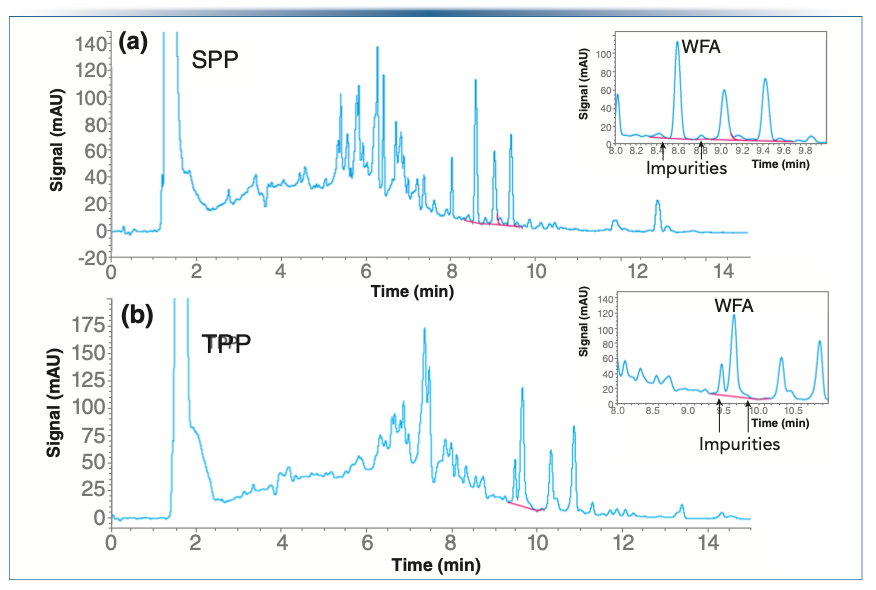
When the flow was increased by 50% (Figure 4), the SPP column maintained separation between WFA (tR = 5.77 min) and its impurities. On the TPP column, the leading impurity partially coeluted with WFA (tR = 6.47 min), and the trailing impurity completely coeluted with the target compound.
FIGURE 4: WFA separation on preparative LC columns. Gradient time: (a) SPP column—10 min and (b) TPP column—12 min. Inset subfigures show impurities peaks.
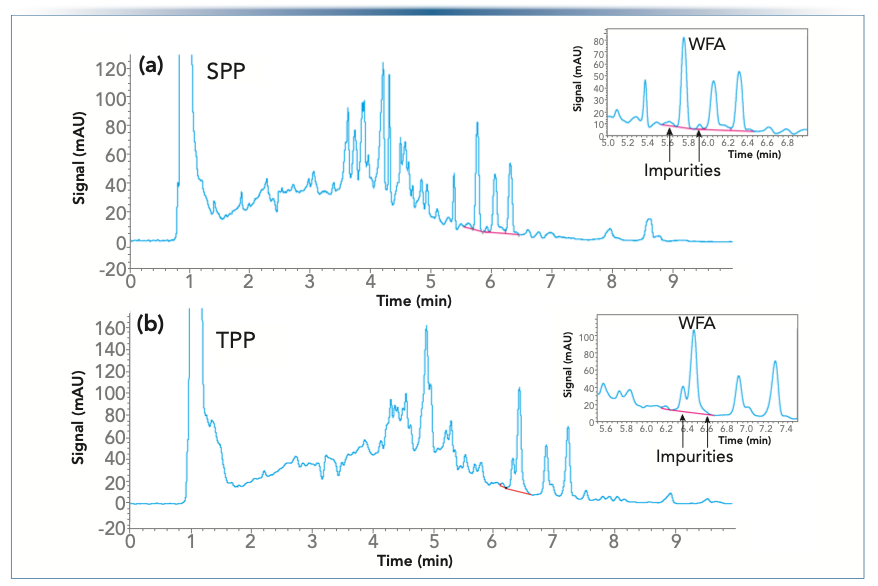
The TPP column was only able to separate impurities at its optimal flow rate, which was an 18-min gradient. Meanwhile, the faster gradient on the SPP column was able to separate all peaks in 10 min, reducing the run time by 45%.
Conclusion
The SPP preparative LC column successfully separated WFA from adjacent impurities with minimal method development. When run at 1.5 times the optimal flow, the SPP column maintained the separation, whereas the TPP column had significant coelution. The faster SPP method resulted in a 45% decrease in run time over the TPP method at standard flow. Therefore, this study shows that the speed and loading ability of the 4 μm SPP preparative LC columns are well suited to the needs of high-throughput discovery laboratories.
References
(1) A. Gratzfeld-Huesgen and E. Naegele, Maximizing Efficiency Using Agilent InfinityLab Poroshell 120 Columns. Agilent Technologies Application Note, 5990 5602EN, 2016.
(2) T. Alvarez-Suegura, J. Chromatogr. A 1584(11), 126–134 (2019).
(3) J. Bolleddula, Rapid Commun. Mass Spectrom. 26(11), 1277–1290 (2012).
Lakshmi Subbarao has over 15 years of experience in the chromatography industry, including analysis and purification of pharmaceutical and natural products. She has provided training and consultation services to Fortune 100 pharmaceutical companies and her work has been published in many industry magazines. She received a Bachelor of Science degree in Chemistry from the University of Delaware and a Master’s degree in Analytical Chemistry from Illinois Institute of Technology. Lakshmi is currently a Senior Applications Scientist at Agilent Technologies. Direct correspondence to: lakshmi.subbarao@agilent.com

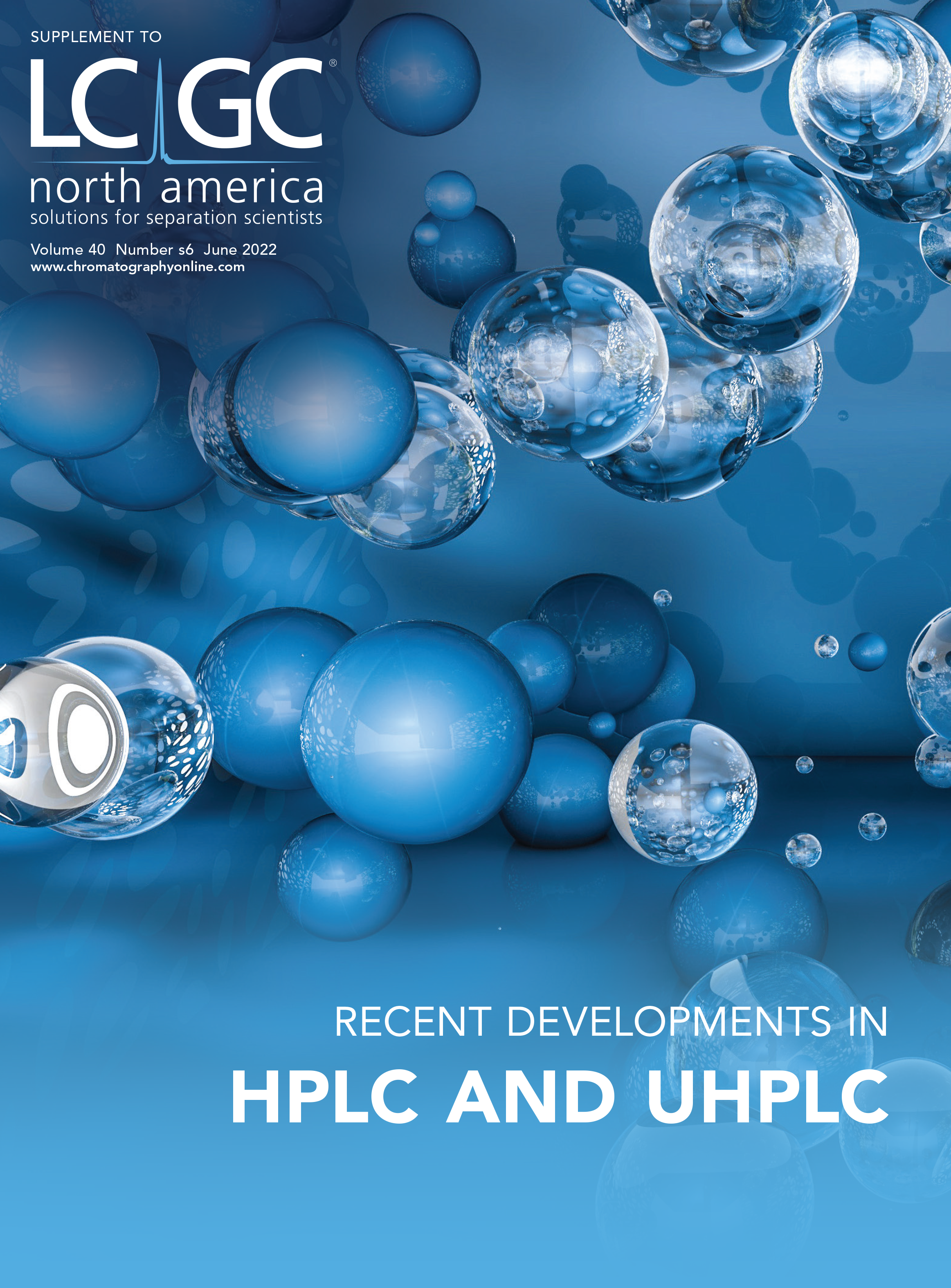
Common Challenges in Nitrosamine Analysis: An LCGC International Peer Exchange
April 15th 2025A recent roundtable discussion featuring Aloka Srinivasan of Raaha, Mayank Bhanti of the United States Pharmacopeia (USP), and Amber Burch of Purisys discussed the challenges surrounding nitrosamine analysis in pharmaceuticals.

